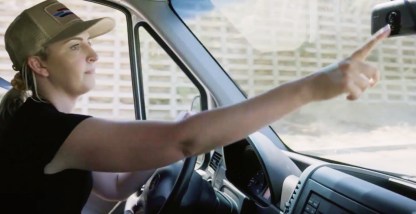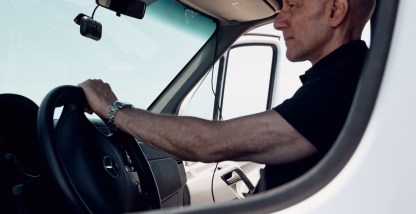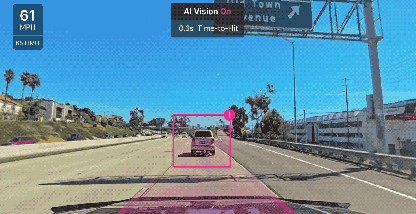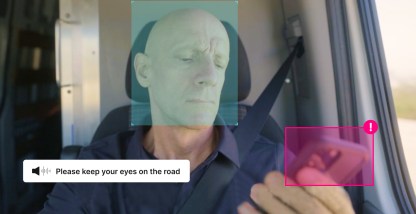Ask professional drivers how they feel about dual-facing dash cams, and you may not get a positive response. But sentiment about dual-facing dash cams has changed the more that drivers have used them. Operators are starting to see that these cameras protect their livelihood and their reputation.
A recent survey of Motive AI Dashcam customers showed that after implementing dual-facing AI Dashcams, respondents experienced a driver turnover of less than 5%. In fact, businesses that use inward-facing cameras saw a 3% increase in driver retention after 75 weeks when benchmarked against road-facing dash cam users. This was true for fleets of all sizes.
As dash cam acceptance grows, word is spreading about the ways inward-facing cameras support drivers. Here are some of the biggest ways that dual-facing dash cams are earning drivers’ trust.
Protection from road rage and hit-and-runs
If you think North American roads have gotten more dangerous, you’re right. Deaths per million miles traveled have risen 18% since 2019. Frequent speeding and a decline in enforcement are big reasons why. Officer resignations were up 47% last year compared to pre-pandemic 2019. Officer retirements rose 19%.
In an environment like this, drivers need all the protection they can get — and the AI Dashcam is quick to provide it. Motive’s “Quick Capture” feature lets drivers instantly record the high-risk incidents around them. When drivers are cut off, boxed in, or worried about an aggressive driver, they can document the incident with the push of a button. Drivers can instantly share dash cam footage with their safety team, so the video can be used to exonerate drivers of wrongdoing or educate the team on best practices.
When a collision does happen and drivers are the victims of a hit-and-run, safety managers get alerted automatically, letting them check on drivers and send help right away. That level of care can make drivers feel valued and earn their trust.
Hear what operators like about AI Dashcams, in their own words.
Exoneration
Nobody likes to be wrongly accused, especially for something as consequential as an accident. For professionals who drive on the job, false claims can tarnish reputations and leave businesses on the hook for thousands of dollars. If a driver is falsely accused of causing an accident, dash cam video can instantly prove the operator’s innocence. This is true whether fleets are using dual-facing or road-facing dash cams.
“With the Motive cameras, it took us about 17 seconds to understand what happened and exonerate our driver.” — Don Penepent, Concrete Division Manager at Tilcon
The Motive AI Dashcam captures incidents in ultrawide, high-definition (HD) 1440p, leaving little doubt about what took place or who’s liable. Since adopting dash cams, 80% of Motive customers surveyed have been exonerated for not-at-fault accidents. Recent data from the American Transportation Research Institute (ATRI) suggests that dual-facing dash cams exonerate drivers in more than half of insurance claims and nearly half of court cases.
Professional development
Over time, unsafe habits such as close following and distracted driving can easily become ingrained in drivers. Drivers may not even realize it’s happening. AI fleet dash cams can improve these safety lapses in real-time, alerting operators to them as they arise. Unsafe driving behaviors get corrected before causing a crash, leading to fewer sit-downs with drivers after the fact. Driver approval of dual-facing dash cams is 19% higher when dash cams are used proactively, reflecting a preference for positive safety approaches over punitive ones.
Dash cams facilitate continuous improvement
As modern technology gives operators more autonomy, they’re using this freedom to grow faster and smarter. Here’s how they’re approaching it.
1. Self-coaching through driver apps
- After every unsafe driving incident, modern driver apps like the one from Motive automatically deliver coaching tips to operators, allowing them to self-coach through their smartphones, without a manager’s involvement.
- App-based coaching is fast and easy, empowering drivers to take control of their own growth on their own time.
2. Improving performance and morale
- Safer driving performance ensures better road safety, of course. It also boosts operators’ confidence. The longer drivers go without triggering an unsafe event, the more confident they’ll become.
- A track record of fewer close calls and accidents creates opportunities for promotion, recognition, and peer respect, giving operators more pride in their work.
3. Using safety scores to track performance
- Driver safety scores serve as reliable tools for evaluating performance based on driving metrics (cell phone use, speeding, and close following, for example).
- Beyond identifying areas for coaching, scorecards help managers recognize and reward drivers for improvement and excellence.
- Gamifying safety through scorecards sparks friendly competition among drivers, promoting a positive and collaborative environment that keeps teams engaged.
Driver privacy
When operators resist dual-facing dash cams, it’s usually because they’re concerned about losing their privacy. They don’t often realize that some dash cams come equipped with features designed to protect their privacy. Driver Privacy Mode on the AI Dashcam, for example, gives drivers the option to disable the driver-facing camera while they’re off duty.
Admins can activate Driver Privacy Mode for a driver, a group, or the entire fleet. Motive can automatically enable Driver Privacy Mode when the engine is off or idling, so drivers can rest easy knowing that their private moments are just that — private.
The Motive AI Dashcam — Elevate the driving experience
Looking to improve dash cam acceptance in your fleet? These tips from ATRI can help. Embrace a future with AI Dashcams. Request a demo today.










